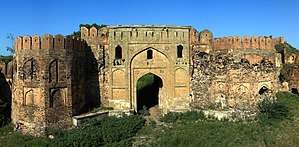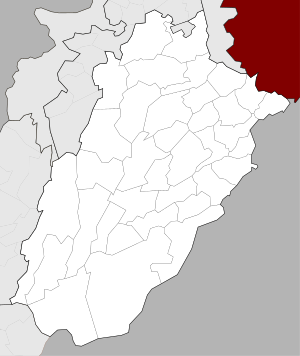Attock
| Attock City اٹک Campbellpur | |
|---|---|
| City | |
 | |
 Attock City  Attock City | |
| Coordinates: 33°46′0″N 72°22′0″E / 33.76667°N 72.36667°ECoordinates: 33°46′0″N 72°22′0″E / 33.76667°N 72.36667°E | |
| Country | Pakistan |
| Province | Punjab |
| Established | 1904 |
| Incorporated | 1978 |
| Time zone | UTC5 (PKT) |
| Postal code span | 43600 |
| Area code(s) | 057 |
| Website | www.attockonians.com |
Attock City (Punjabi, Urdu: اٹک), formerly Campbellpore or Campbellpur (کیمبل پور) until 1978,[1] is a city located in northern part of Punjab Province in Pakistan near the country's capital Islamabad in the Panjistan region, and is the headquarters of Attock District. Attock was founded in 1908 several miles southeast of the older city of Attock Khurd,[2] which had been established by the Mughal Emperor Akbar in the 16th century,[3] and was initially named in honour of Sir Colin Campbell.[4]
Etymology
The city was initially named Campbellpore, also spelt Campbellpur, in 1908 in honour of Sir Colin Campbell.[4] The name was changed in 1978 to Attock, which literally means "Foot of the Mountain."[3]
Geography
Attock is located near the Haro River, a tributary of the Indus River, 80 km (50 mi) from Rawalpindi, 100 km (62 mi) from Peshawar, and 10 km (6 mi) from the Pakistan Aeronautical Complex, Kamra.
History
Background
Attock is located in a historically significant region. Gandhara was an ancient kingdom extending to the Swat valley and the Potohar plateau regions of Pakistan as well as the Jalalabad district of northeastern Afghanistan. Situated astride the middle Indus River, the region had Takshashila and Peshawar as its chief cities. The place is of both political and commercial importance, as the Indus is here crossed by the military and trade route through the Khyber Pass into Afghanistan. Alexander the Great, Timur and Nader Shah crossed the Indus at or about this spot in their respective invasions of India.[5]
The Attock fort was completed in 1583 under the supervision of Khawaja Shamsuddin Khawafi, a minister of Emperor Akbar.[6] The Battle of Attock took place at Attock Khurd on 28 April 1758 between Indian Maratha Kingdom and the Durrani Empire. The Marathas under Raghunathrao Ballal Peshwa and Maharaja Tukojirao Holkar Bahadur were victorious in the battle and Attock was captured.[7] On 8 May 1758, the Marathas defeated Durrani forces in the Battle of Peshawar and captured the city of Peshawar. Marathas had now reached the Afghanistan border. But this conquest was short-lived and then Nawab of Punjab captured the Attock which was followed by Ahmad Shah Durrani as he got alarmed with this defeat and again occupy Attock under a treaty with Nawab. According to which, Attock was divided between Afghans and Nawab. After the decline of the Mughal Empire, the Sikhs invaded and occupied Attock District. The Sikhs established religious freedom and respected the native Muslims. The Sikh Kingdom (1701–1849) under Maharaja Ranjit Singh (1780–1839) captured the fortress of Attock in 1813 from the Afghan Kingdom Nawab of Punjab.
In 1849, Attock Khurd (Old Attock) was conquered by the British East India Company who created Campbellpur District. Following the Indian Rebellion in 1857, the region's strategic value was appreciated by the British, who established the Campbellpur Cantonment in 1857-58.[2] Campbellpore District was organised in 1904,[2] by the division of Talagang Tehsil in the Jhelum District with the Pindigheb, Fateh Jang and Attock tehsils from Rawalpindi District.
Founding
The city's foundations were laid in 1908 by Sir Colin Campbell, the British Commander-in-Chief of India for whom the city is named.[2] The old city was established near the 16th century near the Attock fort that had guarded the major routes between Central Asia and South Asia. Attock's first oil well was drilled in Khaur in 1915,[8] while the Attock Oil Company was established.[9] It has an oil and gas field Dakhini near Jand and in Fateh Jang.
Modern
After the independence of Pakistan in 1947, the minority Hindus and Sikhs emigrated to India, while Muslim refugees from India settled in Attock. The Government of Pakistan renamed Campbellpur as Attock in 1978.[3] The city and surrounding area are known for their high representation among soldiers of the Pakistani Military.[10]
Education
According to the Alif Ailaan Pakistan District Education Rankings 2014, Attock is ranked 3 out of 146 districts of Pakistan in terms of the quality of education. For facilities and infrastructure, the district is ranked 17 out of 146.[11] A detailed picture of the district's education performance is also available online.[12] Army Public School & College, Government Polytechnic Institute,[13] Beacon Light English Model Secondary School[14] and COMSATS University Islamabad are few important educational institutes in Attock.
See also
References
- ↑ Shackle, Christopher (1980). "Hindko in Kohat and Peshawar". Bulletin of the School of Oriental and African Studies. 43 (3): 482. doi:10.1017/S0041977X00137401. ISSN 0041-977X.
- 1 2 3 4 Pike, John. city.htm "Attock City Cantonment" Check
|url=value (help). www.globalsecurity.org. Retrieved 2018-03-09. - 1 2 3 Everett-Heath, John (2017-12-07). The Concise Dictionary of World Place Names. Oxford University Press. ISBN 9780192556462.
- 1 2 Everett-Heath, John (2017-12-07). city%20campbell&f=false The Concise Dictionary of World Place Names Check
|url=value (help). Oxford University Press. ISBN 9780192556462. - ↑

- ↑ Hasan, Shaikh Khurshid (2005). Historical forts in Pakistan. National Institute of Historical & Cultural Research Centre of Excellence, Quaid-i-Azam University. p. 37. ISBN 978-969-415-069-7. Retrieved 17 July 2011.
- ↑ "Attock to Cuttack, PM Narendra Modi causes a stir". The Economic Times. June 27, 2017.
- ↑ World oil. Gulf Publishing Company. March 1947. p. 12. Retrieved 17 July 2011.
- ↑ (India), Punjab (1932). Punjab District Gazetteers: Attock district, 1930. Superintendent, Government Printing.
- ↑ Jaffrelot, Christophe (2015-08-15). The Pakistan Paradox: Instability and Resilience. Oxford University Press. ISBN 9780190613303.
- ↑ "Alif Ailaan Pakistan District Education Rankings, 2014" (PDF). Alif Ailaan. Retrieved 2014-05-06.
- ↑ "Individual district profile link, 2014" (PDF). Alif Ailaan. Retrieved 2014-05-06.
- ↑ "Government Polytechnic Institute".
- ↑ "Beacon Light English Model Secondary School official website". Beacon Light English Model Secondary School.